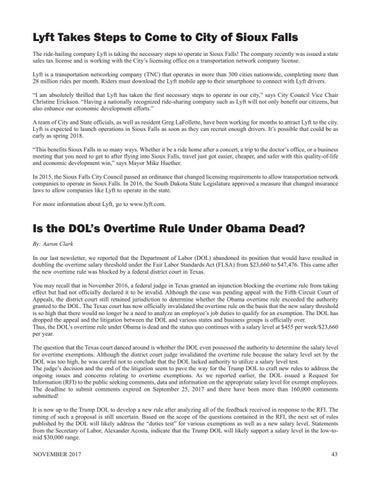Lyft Takes Steps to Come to City of Sioux Falls
The ride-hailing company Lyft is taking the necessary steps to operate in Sioux Falls! The company recently was issued a state sales tax license and is working with the City’s licensing office on a transportation network company license.
Lyft is a transportation networking company (TNC) that operates in more than 300 cities nationwide, completing more than 28 million rides per month. Riders must download the Lyft mobile app to their smartphone to connect with Lyft drivers.
“I am absolutely thrilled that Lyft has taken the first necessary steps to operate in our city,” says City Council Vice Chair Christine Erickson. “Having a nationally recognized ride-sharing company such as Lyft will not only benefit our citizens, but also enhance our economic development efforts.”
A team of City and State officials, as well as resident Greg LaFollette, have been working for months to attract Lyft to the city. Lyft is expected to launch operations in Sioux Falls as soon as they can recruit enough drivers. It’s possible that could be as early as spring 2018.
“This benefits Sioux Falls in so many ways. Whether it be a ride home after a concert, a trip to the doctor’s office, or a business meeting that you need to get to after flying into Sioux Falls, travel just got easier, cheaper, and safer with this quality-of-life and economic development win,” says Mayor Mike Huether.
In 2015, the Sioux Falls City Council passed an ordinance that changed licensing requirements to allow transportation network companies to operate in Sioux Falls. In 2016, the South Dakota State Legislature approved a measure that changed insurance laws to allow companies like Lyft to operate in the state. For more information about Lyft, go to www.lyft.com.
Is the DOL’s Overtime Rule Under Obama Dead? By: Aaron Clark
In our last newsletter, we reported that the Department of Labor (DOL) abandoned its position that would have resulted in doubling the overtime salary threshold under the Fair Labor Standards Act (FLSA) from $23,660 to $47,476. This came after the new overtime rule was blocked by a federal district court in Texas.
You may recall that in November 2016, a federal judge in Texas granted an injunction blocking the overtime rule from taking effect but had not officially declared it to be invalid. Although the case was pending appeal with the Fifth Circuit Court of Appeals, the district court still retained jurisdiction to determine whether the Obama overtime rule exceeded the authority granted to the DOL. The Texas court has now officially invalidated the overtime rule on the basis that the new salary threshold is so high that there would no longer be a need to analyze an employee’s job duties to qualify for an exemption. The DOL has dropped the appeal and the litigation between the DOL and various states and business groups is officially over. Thus, the DOL’s overtime rule under Obama is dead and the status quo continues with a salary level at $455 per week/$23,660 per year.
The question that the Texas court danced around is whether the DOL even possessed the authority to determine the salary level for overtime exemptions. Although the district court judge invalidated the overtime rule because the salary level set by the DOL was too high, he was careful not to conclude that the DOL lacked authority to utilize a salary level test. The judge’s decision and the end of the litigation seem to pave the way for the Trump DOL to craft new rules to address the ongoing issues and concerns relating to overtime exemptions. As we reported earlier, the DOL issued a Request for Information (RFI) to the public seeking comments, data and information on the appropriate salary level for exempt employees. The deadline to submit comments expired on September 25, 2017 and there have been more than 160,000 comments submitted!
It is now up to the Trump DOL to develop a new rule after analyzing all of the feedback received in response to the RFI. The timing of such a proposal is still uncertain. Based on the scope of the questions contained in the RFI, the next set of rules published by the DOL will likely address the “duties test” for various exemptions as well as a new salary level. Statements from the Secretary of Labor, Alexander Acosta, indicate that the Trump DOL will likely support a salary level in the low-tomid $30,000 range. NOVEMBER 2017
43










